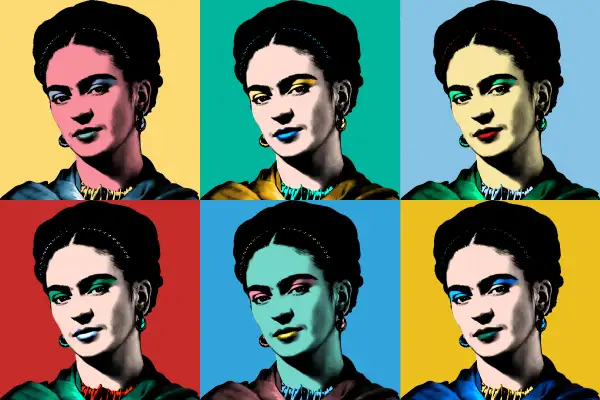The Strange Story of How Frida Kahlo's Face Ended Up on an $8 Bottle of CVS Nail Polish

In 1946, shortly before her 40th birthday, Frida Kahlo painted what might be the most tragic self-portrait in her whole collection.
It’s called “The Wounded Deer,” and re-imagines the Mexican artist as prey; pierced by a shock of arrows and left to die in a forest clearing. Her face, framed by those famous eyebrows, is stoic.
Kahlo suffered from a great many hardships in her life—illness, chronic pain, a marriage that collapsed on itself more than once—and her art was often a direct reflection of those struggles. While she painted “The Wounded Deer,” Kahlo was recovering from a failed bone graft operation, contemplating her mortality, and, depending on which expert you talk to, probably hallucinating on a megadose of prescription morphine.
How strange, then, to find a replica of that very painting on a bottle of drugstore nail polish — nestled between a stack of Us Weeklys and a pile of hand sanitizers near the checkout counter. Stranger still, maybe, to grab a bottle of that polish—or the Frida™ lipstick right next to it—throw it in your basket, and hand the cashier $7.99. And yet, at 3,000 CVS stores nationwide, así es la vida.
The tortured life of this long-dead artist—celebrated for her abandonment of Western ideals—and the fluorescent glow of one of the most jarringly American places you could find yourself, is an odd pairing. But after years of seeing her image on everything from t-shirts to Tequila, it’s also something of a milestone. We’ve hit peak Frida, baby.
“It’s really ironic,” says Leila Amineddoleh, a New York-based art heritage lawyer and expert. “Frida doesn’t symbolize an ‘American’ concept of beauty. She was known for being a strong woman, not a coiffed beauty queen. I doubt she ever thought she’d be a symbol for beauty products.”
To be fair, this has been a long time coming.
The first wave of "Fridamania,” hit the U.S. back in 1981, with the debut of Frida, biographer Hayden Herrera’s best-selling book. The 2002 movie adaptation, starring Salma Hayek, cemented Kahlo as a lasting pop culture icon—on par with the likes of Marilyn Monroe, Andy Warhol and Bob Marley—and ushered in a tsunami of apparel, coffee table books, and other Frida-themed merch.
Sixteen years later, we’ve got Frida Kahlo iPhone cases (tons of them, actually), Frida Kahlo coffee mugs, Frida Kahlo paper dolls. There are Frida graphic tees at Hot Topic, and Frida wall hangings at Urban Outfitters. For those who prefer to support local retailers, blessed news: a search for “Frida” on Etsy returns nearly 30,000 results.
The hype makes sense. This is, after all, an era of authenticity, and speaking truth to power. Kahlo, unapologetic and unashamed about who she was and what she’d been through, dated both men and women, wore whatever she wanted, and darkened her facial hair with a brow pencil. As gender lines become fuzzier, and more people outside the margins of white heteronormativity fight for a voice, she’s never been more relevant.
Kahlo’s presence in the drugstore beauty aisle aligns with another trend, too. Cosmetic companies are, at long last, developing products for a wide range of skin tones, and are finally adding diversity to their advertising campaigns (see: Issa Rae’s recent CoverGirl spot, or trans model Hari Nef’s one for Loreal). Make no mistake — the industry still values traditional standards of beauty, and models with more Instagram followers than artistic accolades. But even in a market dominated by Lip Kits by Kylie and Fenty by Rihanna, Kahlo is leaving her mark.
The CVS line debuted in 2016, with bright, trendy, colors like turquoise and chartreuse, and packaging that borrows heavily from the artist’s work. Pierced hearts, sugar skulls, and other Kahlo motifs cover every bottle of nail polish and lipstick. So does Kahlo's signature — as if the artist herself had some say in the matter.
“This is an artist who was powerful, and confrontational,” says Hillary Belzer, who writes about the intersection of cosmetics and art on her blog, Makeup Museum. “That appeals to a lot of people.”
Today, the products are available at about 30% of CVS stores, so there’s still an air of exclusivity. And while neither the drugstore chain nor Republic Cosmetics, a Mexican company that supplies the merchandise, would comment on sales, a CVS spokeswoman says the items are popular with customers.
“As soon as I saw that this was an actual product, I started stalking all the CVS stores by me,” says Xochitl Carmona, a Chicago-based beauty blogger. “I knew I wanted to keep one of these in my purse.”
Carmona is an avid beauty consumer — the 27-year-old does freelance makeup work and has a YouTube channel devoted to beauty product reviews. Quality-wise, the Frida merch isn’t that different from all the other lipsticks and nail polishes in the CVS beauty aisle, she says. But the packaging is striking, and culturally significant. Carmona’s family is from Mexico, and she says she loves seeing her heritage represented, even if it’s in a drugstore bargain bin.
“There are so many makeup brands out there,” Carmona says. “Sometimes, what something represents is what sways me to buy it.”
Would Kahlo be cool with this?
The artist’s commercial success came after she died, and Kahlo didn’t leave a will, or any instructions dictating how her work should be used.
Today, Kahlo’s branding licenses belong to the Frida Kahlo Corporation, which was founded by her late niece, and has been managed by Beatriz Alvarado (who is not a relative) since 2007. The corporation has a reputation for doling out permissions far and wide — in an interview with Artsy last year, Alvarado said that since Kahlo painted self-portraits, and wore colorful, attention-grabbing clothing, it’s simply carrying on a tradition set by the artist.
“She sold herself, in a way,” Alvarado told the site. “We’re just doing what she did.”
Kahlo’s living relatives aren’t so keen. When Mattel debuted a Frida-inspired Barbie doll earlier this year—toning down her unibrow to just a few strands of hair—some of them sued. A Mexican court granted a temporary injunction on sales of the $30 doll, but as of this writing, it’s still available in the U.S..
The artist’s politics are even harder to reconcile with her lucrative, posthumous image. Outspoken in her beliefs, Kahlo protested against Western imperialism, and what she saw as oppressive labor conditions sanctioned by the U.S.
How would she feel about her commercialized, cutesy-fied legacy? Or the scaled-down versions of her most haunting self-portraits, now used to sell a mind-boggling number of factory-made, internationally-produced goods?
“It’s a sticky situation,” says Hillary Belzer, the Makeup Museum blogger. “To see these bland, watered down images, and elements of her paintings that are not really the paintings, it loses its power.
Still, Belzer admits, “I would love to see a brow line.”
